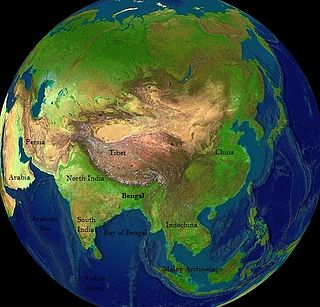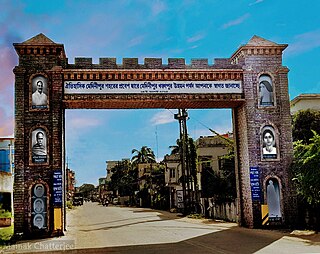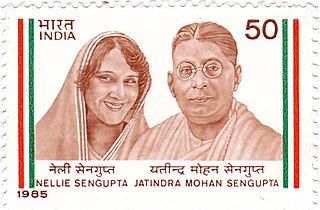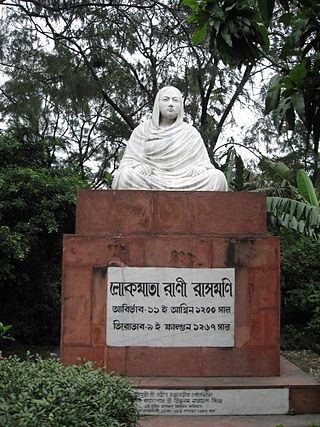
Bengal is a historical geographical, ethnolinguistic and cultural term referring to the eastern part of the Indian subcontinent at the apex of the Bay of Bengal. The region of Bengal proper is divided between modern-day Bangladesh and the Indian state of West Bengal. The Indian states of Assam and Tripura have a sizeable Bengali population. A large Bengali diaspora exists across the world. Bengali is the sixth-most spoken language in the world.

Abul Kasem Fazlul Huq, popularly known as Sher-e-Bangla, was a Pakistani Bengali lawyer and politician who presented the Lahore Resolution which had the objective of creating an independent Pakistan. He also served as the first and longest Prime Minister of Bengal during the British Raj.

Medinipur or Midnapore is a city known for its history in the Indian state of West Bengal. It is the headquarters of the West Medinipur district. It is situated on the banks of the Kangsabati River. The Urban Agglomeration of Midnapore consists of the city proper, Mohanpur, Keranichati and Khayerullachak. Midnapore and it's neighbouring city of Kharagpur constitute the central core of the Midnapore Kharagpur Development Authority metro area, spread across 576 square kilometres.

Sir Brajendra Nath Seal was a Bengali Indian humanist philosopher. He served as the second vice chancellor of Mysore University.

The history of Bengal is intertwined with the history of the broader Indian subcontinent and the surrounding regions of South Asia and Southeast Asia. It includes modern-day Bangladesh and the Indian states of West Bengal, Tripura and Assam's Karimganj district, located in the eastern part of the Indian subcontinent, at the apex of the Bay of Bengal and dominated by the fertile Ganges delta. The region was known to the ancient Greeks and Romans as Gangaridai, a powerful kingdom whose war elephant forces led the withdrawal of Alexander the Great from India. Some historians have identified Gangaridai with other parts of India. The Ganges and the Brahmaputra rivers act as a geographic marker of the region, but also connects the region to the broader Indian subcontinent. Bengal, at times, has played an important role in the history of the Indian subcontinent.

Anushilan Samiti was an Indian fitness club, which was actually used as an underground society for anti-British revolutionaries. In the first quarter of the 20th century it supported revolutionary violence as the means for ending British rule in India. The organisation arose from a conglomeration of local youth groups and gyms (akhara) in Bengal in 1902. It had two prominent, somewhat independent, arms in East and West Bengal, Dhaka Anushilan Samiti, and the Jugantar group.

Bengalis, also rendered as Bangalee or the Bengali people, are an Indo-Aryan ethnolinguistic group originating from and culturally affiliated with the Bengal region of South Asia. The current population is divided between the independent country Bangladesh and the Indian states of West Bengal and Tripura, Barak Valley, Andaman and Nicobar Islands, Jharkhand and part of Meghalaya and Manipur. Most of them speak Bengali, a language from the Indo-Aryan language family.

Nellie Sengupta was an Englishwoman who fought for Indian Independence. She was the first woman Alderman for Calcutta and was elected president of the Indian National Congress at its 48th annual session at Calcutta in 1933.

Eastern Bengal and Assam was an administrative subdivision (province) of British India between 1905 and 1912. Headquartered in the city of Dacca, it covered territories in what are now Bangladesh, Northeast India and Northern West Bengal.

The Partition of Midnapore was the administrative breakup of the Midnapore District of West Bengal, India into the western Paschim Medinipur and the eastern Purba Medinipur districts that became effective on 1 January 2002. With a collective population of 97 lakh or 9.7 million, the undivided district was the largest in terms of population in India and more populous than many countries, including Sweden. With the division of the district, the subdivisions of Medinipur Sadar, Kharagpur, Jhargram, and Ghatal were placed in Paschim Medinipur, with Midnapore, now the district headquarters of only the western half. The subdivisions of Tamluk, Contai, and Haldia were placed in the eastern district with district headquarters at Tamluk. Egra subdivision, a new subdivision of Purba Medinipur, was created out of the Contai subdivision.

Mahishya, also spelled Mahisya, is a Bengali Hindu traditionally agrarian caste, and formed the largest caste in undivided Bengal. Mahisyas were, and are, probably the most diverse Bengali caste counting among themselves all possible classes in terms of material conditions and ranks.

Abul Hashim was a Bangladeshi politician and Islamic thinker in the Indian Subcontinent.

Fazlul Quader Chowdhury (1919–1973) was a Bengali politician who served as the 5th speaker of the National Assembly of Pakistan from East Pakistan. He belonged to Ayub Khan's Convention Muslim League. He was also the Acting President of Pakistan from time to time when Ayub Khan left the country. His elder brother Fazlul Kabir Chowdhury was the leader of the opposition in East Pakistan assembly. Quader was preceded by Maulvi Tamizuddin Khan of Awami League.

Bangladesh's military history is intertwined with the history of a larger region, including present-day India, Pakistan, Nepal, Bhutan and Myanmar. The country was historically part of Bengal– a major power in South Asia and Southeast Asia.

Jatindra Mohan Sengupta was an Indian revolutionary against the British rule. He was arrested several times by the British police. In 1933, he died in a prison located in Ranchi, India.

Hemanta Kumar Sarkar was an Indian philologist, author, biographer, editor, publisher, union leader, leader of the Indian freedom movement and an associate of Subhas Chandra Bose. He was a close friend and the first biographer of Subhas Chandra Bose, the co-founder of Labour Swaraj Party in Bengal along with Muzaffar Ahmed and Kazi Nazrul Islam and led the movement for the Partition of Bengal and formation of Bengali Hindu homeland in 1947.

Bengali Muslims are adherents of Islam who ethnically, linguistically and genealogically identify as Bengalis. Comprising about two-thirds of the global Bengali population, they are the second-largest ethnic group among Muslims after Arab Muslims. Bengali Muslims make up the majority of Bangladesh's citizens, 90 percent of the Bangladeshis are Bengali Muslims, and are the largest minority in the Indian states of West Bengal, Tripura and Assam.

Sikhism in Bangladesh has an extensive heritage and history, although Sikhs had always been a minority community in Bengal. Their founder, Guru Nanak visited a number of places in Bengal in the early sixteenth century where he introduced Sikhism to locals and founded numerous establishments. In its early history, the Sikh gurus despatched their followers to propagate Sikh teachings in Bengal and issued hukamnamas to that region. Guru Tegh Bahadur lived in Bengal for two years, and his successor Guru Gobind Singh also visited the region. Sikhism in Bengal continued to exist during the colonial period as Sikhs found employment in the region, but it declined after the partition in 1947. Among the eighteen historical gurdwaras in Bangladesh, only five are extant. The Gurdwara Nanak Shahi of Dhaka is the principal and largest gurdwara in the country. The Sikh population in the country almost entirely consists of businessmen and government officials from the neighbouring Republic of India.
Ashrafuddin Ahmad Chowdhury was a Bengali politician who had served as general secretary of the Congress Party's Bengal branch, member of the East Bengal Legislative Assembly and later as the Education Minister of Pakistan. He was an advocate of Huseyn Shaheed Suhrawardy's United Bengal proposal.

Jatra Mohan Sengupta or Jatramohan Sen (1850-1919) was a Bengali lawyer and politician.


















